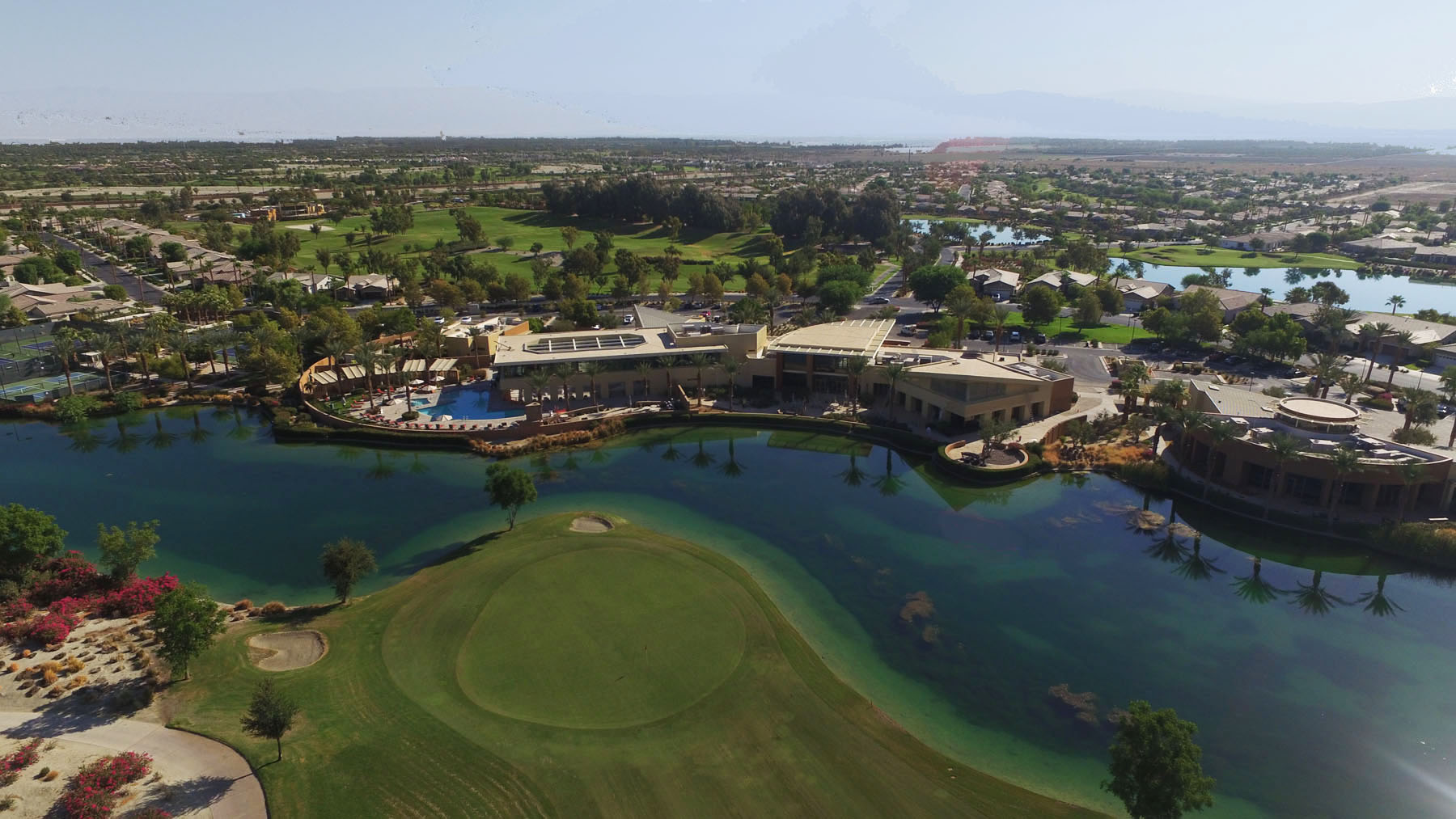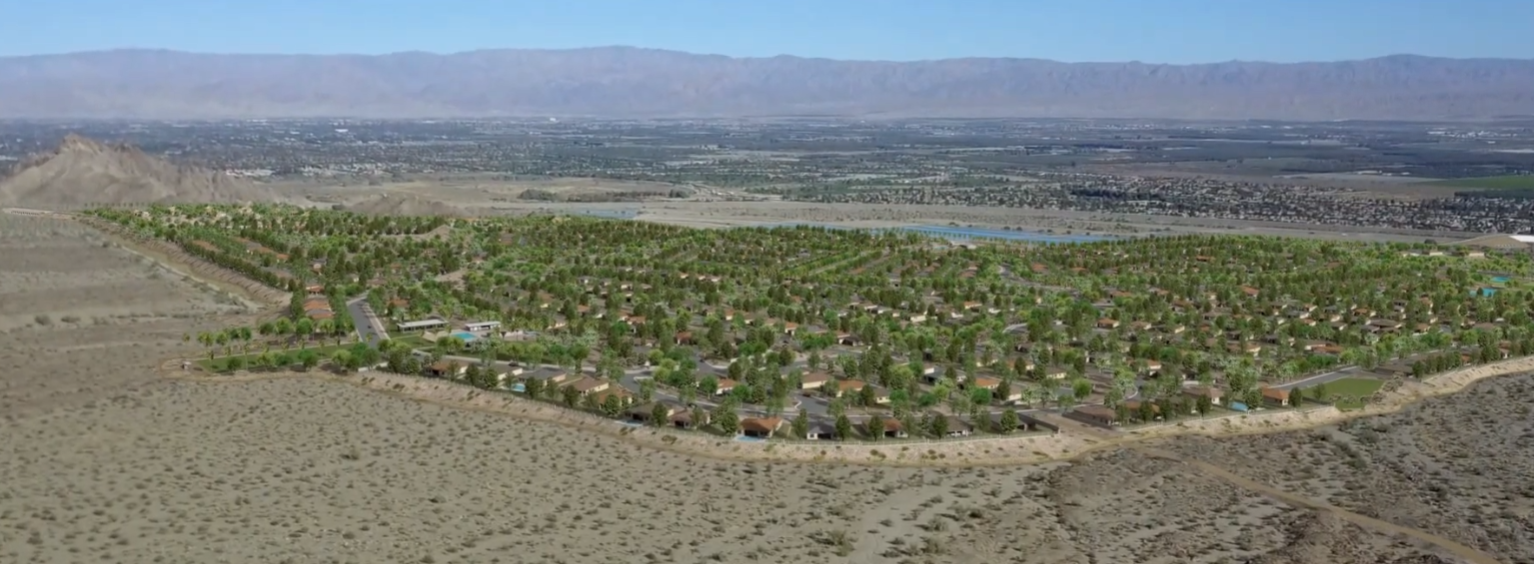In a decision that marks the culmination of nearly four decades of planning and debate, the La Quinta City Council has given the green light to the ambitious Travertine development project. The approval came in a 4-0 vote on August 8, 2024 (Mayor Linda Evans was absent because she was attending the meeting where her employer, Tenet Health, gained approval by Desert Healthcare District for a Nov. 5 ballot measure for the massive lease/purchase agreement for Desert Regional Medical Center). It paves the way for the construction of a sprawling mixed-use community on 855 acres of land located south of Coral Mountain and west of the Trilogy community. The project, now significantly scaled down from its original 1995 version, reflects both the evolving vision of its developers and the changing priorities of the La Quinta community.
A Long Road to Approval
The Travertine project’s history stretches back to the late 1980s when landowner Ken Hoffman first envisioned transforming the area. The initial Travertine and Green Specific Plan approved in 1995, was far more extensive, permitting up to 2,300 residential units, a 500-room resort hotel, two golf courses, and a tennis club across 909 acres. However, changing environmental regulations, economic considerations, and shifting community values led to a series of modifications over the years, ultimately resulting in the current plan, which is significantly smaller in scope.
Mark Rogers, a developer with TRG Land, the Newport Beach-based company leading the project, emphasized the importance of community and environmental stewardship in the revised plans. “This project has been around for a long time,” Rogers said during the council meeting. “We’ve worked closely with the community, past and present council members, and city staff to create a project that not only meets but exceeds the expectations of La Quinta residents.”
The Approved Plan: What’s Included?
The approved Travertine plan allows for the construction of up to 1,200 residential units and a 100-room wellness resort. Notably, over a third of the property will remain as open natural space, a significant departure from the original plan, which featured two golf courses. Instead, the development will include a four-hole golf training facility, a driving range, and various teaching areas. The resort, planned for the northern part of the development, is designed to complement the natural surroundings with a focus on wellness and sustainability.
In addition to the residential and resort components, the project will feature a five-mile trail system designed to connect with the nearby Boo Hoff Trail, enhancing the recreational offerings in the area. An eight-foot perimeter fence will be installed to protect the local bighorn sheep population, a testament to the project’s commitment to environmental conservation.
The main entrance to the Travertine development will be located on Avenue 62, with an emergency vehicle access road connecting to Madison Street. The council acknowledged concerns from residents of the neighboring Trilogy community, who had advocated for an alternative main entrance via an extension of Jefferson Street. However, Rogers noted that such an extension would be contingent on future developments at Coral Canyon, a nearby residential project, and would require extensive regulatory approvals.
A Balancing Act: Environmental and Community Concerns
The scaled-down version of Travertine reflects a careful balancing act between development and environmental preservation. The reduction in the number of residential units and the removal of one of two planned golf courses were responses to mitigation measures outlined in the original Environmental Impact Report (EIR) for the Travertine project. The current plan also includes an increase in open natural space, which will be preserved for conservation purposes.
The decision to scale back the project was not taken lightly. According to Rogers, the developers conducted extensive market and environmental research, ultimately concluding that a smaller footprint would be more sustainable and better aligned with community needs. “We’re providing the next step of infrastructure that will allow the city to expand east into its sphere of influence,” Rogers explained, highlighting the project’s potential to support future growth in La Quinta.
The La Quinta City Council praised the project’s design and its alignment with the city’s long-term development goals. Councilmember Kathleen Fitzpatrick called the vote a “tough decision” but noted that the overall project had received broad support. She noted that the Travertine plans are aligned with the city’s general plan. “One of the things that we’ve all talked about is the general plan,” said Fitzpatrick. “And I really feel like because the original 1995 project was included in the general plan, this project is not out of keeping with it. It’s very difficult to say “no” to a project that fits so well with the city’s established plans.”
The Developer’s Perspective
TRG Land’s approach to the Travertine project has been deeply influenced by the legacy of Ken Hoffman, the original visionary behind the development. Hoffman’s daughter, Lisa Hoffman Morgan, who now leads the family-owned company, has continued her father’s commitment to responsible development. The Hoffmans have been residents of the Coachella Valley for over 50 years, and their deep connection to the area is evident in the project’s design.
During the council meeting, Rogers provided a historical overview of the project, highlighting key milestones from its inception in 1988 to the present day. He noted that the original plan was “just a whisper away” from being built, but changes in market conditions and environmental regulations prompted a re-evaluation of the project’s scope. “It takes a lot of temerity for a developer to give up that much of a project,” Rogers said, referring to the decision to reduce the number of residential units and scale back other aspects of the development. “But we recognized that this was the best path to success.”
One of the most significant changes was the elimination of Madison Street as a major access road, a decision driven by concerns over water impoundment and environmental impact. Instead, the project will be accessed via Avenue 62 and Jefferson Street, although the latter will only be developed in collaboration with future projects at Coral Canyon.
Looking Ahead: The Future of Travertine
With the City Council’s approval, the Travertine project is set to begin its first phase of construction, which is expected to be completed by 2029. Subsequent phases will continue into the early 2030s, with the entire development projected to be completed by 2033.
The project’s phased approach will allow the developers to respond to changing market conditions and community needs over time. The first phase will focus on the southern portion of the property, where two large water tanks will be constructed to support the development. The Coachella Valley Water District (CVWD) requested these tanks, which are designed to provide water for both the Travertine project and future developments in the area.
As the project moves forward, the developers have committed to ongoing collaboration with the City of La Quinta and other stakeholders. They have also expressed a willingness to adapt the project as needed to ensure that it remains in harmony with the community’s vision and environmental goals.
The Travertine development represents a significant milestone for La Quinta, one that will shape the city’s future for decades to come. As Councilmember Steve Sanchez noted during the meeting, “It’s always hard when a new development is proposed for vacant land, but I try to always remind everybody that we all live in an area that at one time was just land. There used to be nothing, and there was a better view for some, but at one time, the house that you live in wasn’t there. And it took a developer to do that.”
Referring to the open space the developer will reserve as open space that could have been earmarked for more structures in the development, Sanchez added, “I’ve never seen a developer give up 300 plus acres that they could build upon. If you really care about the environment, as you’re saying, I think we should recognize that. There will be a lot of open land left for nature and people to enjoy on their own.”
Mayor Pro Tem John Pena offered a historical perspective, reflecting on the city’s development history and its commitment to environmental stewardship. “I was here in 1995 when this project was first approved,” said Pena. “I think it was a good project back then, and it’s even better now. When Trilogy was approved, we had comments from people who owned farmland out in the area that we were going to ruin this whole area just like many of the same comments that we heard tonight. We heard from opponents of Trilogy. We heard from opponents to PGA West and from people opposed to Andalusia. But I think we’ve done a good job for our community. I think we’ve been good stewards of our environment.”

A massive, unnecessary lake on the Trilogy La Quinta golf course

Another of several giant golf course lakes. This one surrounds the Trilogy La Quinta recreation center and swimming complex
Meanwhile, at Trilogy, where essentially all of the Travertine opponents (who continue to oppose every development that is envisioned in south La Quinta) live, their golf course, which contains several of the most massive lakes of any golf facility in the region, is under renovation for a fall reopening. Local media reports have recently shown clips of the incredible amount of water being applied to the course to bring it back from the years it sat idle. They advocate huge volumes of water for their development while weaponizing water to fight against a drop for anyone else.




